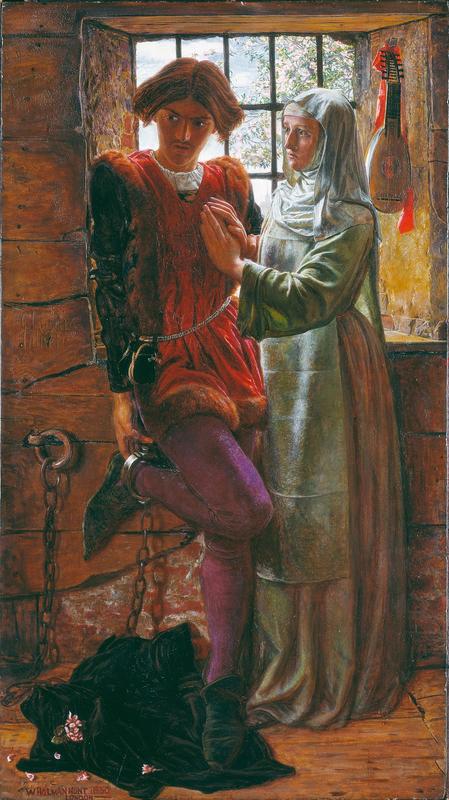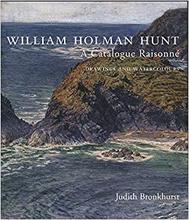More about Claudio and Isabella
- All
- Info
- Shop

Contributor
Claudio and Isabella by William Holman Hunt is a scene taken from a play by The Bard himself, William Shakespeare.
The play is Measure for Measure and the scene is when Claudio asks his sister, who is soon to be a nun, to give up her virginity to the man who is sentencing him to death, so that he can live. Not the greatest move on Claudio’s part. Obviously his sister said no and got pissed about it. If that weren't bad enough, he's in prison in the first place because he couldn’t keep it in his pants and got his mistress pregnant. Granted they were engaged so it’s not that bad. But the substitute ruler of Vienna, Angelo, was trying to make an example out of Claudio, so therefore he had to die. But little does everyone know that Angelo was a little freaky himself. Reasons for freakiness are as follows: 1. He was going to marry his former lover but when he found out her dowry went down in a shipwreck he bailed and 2. He said he’d free Claudio if Isabella would have sex with him. So Isabella dodges both requests for her to have sex and by the end of the play she got a marriage proposal from the real Duke of Vienna. And the hits just keep on coming. Readers are left begging the question, “HOW did the #metoo movement not start earlier, my GOD?”
So now that we have a little context for the painting, we can see all of the symbolism that Hunt used to tell the entire story in just one image. First their facial expressions pretty much tell it all. Claudio is resentful but also ashamed for asking his sister to buy his freedom with her virtue. Isabella is concerned but sad that her own brother would ask her to do such a thing. The apple blossom flower petals that are strewn across Claudio’s cloak on the floor, which were added in 1879, are symbolic of his willingness to sacrifice his sister’s lady flower for his life. We know the outcome of the request because of the teeny tiny little church that pops up oh-so-subtly between them. If this didn’t convince you of Isabella’s piety, then her all white habit should. And last but not least, carved into the frame of this piece are the words, “Claudio. Death is a fearful thing. Isabella. And shamed life is hateful.” Subtlety was certainly not Hunt’s strong suit. At the end of the day Claudio’s life and Isabella’s virginity are spared and Angelo is outed as a pervert douchecanoe. It’s as close to a happily ever after as a woman could get in 1623.
This is one of Hunt’s best pieces, but it almost didn’t happen. After the Pre-Raphaelite paintings were scoffed at at the Royal Academy in 1850, the group fell under difficult financial times. That is until Augustus Egg, a fellow painter who was part of a philanthropic organization called the “Guild of Literature and Art,” started by Charles Dickens and Edward Bulwer-Lytton, gave Hunt an advance. And as soon as he had the funds, Hunt went to Lollard Prison at Lambeth Palace in London, the most dismal place he could think of, to paint both the lute and the interior of the piece. So thanks to a guy named Egg and the dreary aesthetics of Lollard Prison this poignant image of a moral dilemma can depress us for the rest of our lives. Yay?
Sources
- Annabel Rutherford, 'A Dramatic Reading of Augustus Leopold Egg’s Untitled Triptych', Tate Papers, no.7, Spring 2007, Web. 13 March 2018.
- "‘Claudio And Isabella’, William Holman Hunt, 1850 | Tate." Tate. Web. 30 Jan. 2018.
- Hunt, Claudio And Isabella. Mountain View, California: Khan Academy. Video.
- Jeffrey Easby, Rebecca. "William Holman Hunt, Claudio And Isabella - Smarthistory." Smarthistory. Web. 13 Mar. 2018.
- "Sparknotes: Measure For Measure: Overall Summary." Sparknotes.com. Web. 30 Jan. 2018.
Featured Content
Here is what Wikipedia says about Claudio and Isabella
Claudio and Isabella is an 1850 Pre-Raphaelite oil painting by the English artist William Holman Hunt. It is based on a scene from William Shakespeare's Measure for Measure. In this scene, Isabella is made to choose between sacrificing her brother's life or sacrificing her virginity to Angelo. Hunt's image attempts to depict the characters' tangible emotions in the moment that this choice must be made. Hunt summarized the moral as: ‘Thou shall not do evil that good may come.’
Isabella's purity is reflected by her upright position, her plain white habit, and the sun shining on her through the window, out of which a church can be seen in the distance. Her brother Claudio, shackled to the wall, clearly uncomfortable in both mind and body. He is turned away from his sister, ashamed of the circumstances that brought them here and confronted with the fear of his own imminent death.
When it was first put on display at the Royal Academy of Dramatic Art in 1853 it was accompanied by a quotation from the play:
'Tis too horrible!
The weariest, and most loathed worldly life,
That age, ache penury and imprisonment
Can lay on nature, is a paradise
To what we fear of death.In 1864 Hunt issued a pamphlet advertising the engraving of Claudio and Isabella, in which he summarised the picture's 'deep and noble moral' as 'Thou shall not do evil that good may come.'
— Measure for Measure, Act III, scene I
Check out the full Wikipedia article about Claudio and Isabella













